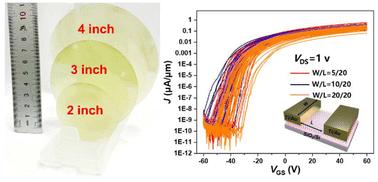Our official English website, www.x-mol.net, welcomes your
feedback! (Note: you will need to create a separate account there.)
Promotion of a Mo-based ionic crystal precursor for MoS2 wafer growth
Nanoscale ( IF 5.8 ) Pub Date : 2024-11-06 , DOI: 10.1039/d4nr02955k Jinxiu Liu, Chunchi Zhang, Yan Huang, Haijuan Wu, Chao Tan, Zegao Wang
Nanoscale ( IF 5.8 ) Pub Date : 2024-11-06 , DOI: 10.1039/d4nr02955k Jinxiu Liu, Chunchi Zhang, Yan Huang, Haijuan Wu, Chao Tan, Zegao Wang

|
Two-dimensional MoS2 semiconductors have emerged as a promising solution for extending Moore's law. Nevertheless, their wafer-scale growth from lab to fab is still in infancy stages within the semiconductor industry. The distribution, concentration, and reactivity of both sulfur and molybdenum precursors exert a substantial influence on the uniformity of MoS2 wafers, including on parameters such as the grain size, thickness, and vacancy density. While considerable emphasis has been directed towards sulfur precursors—such as those derived from ZnS, which facilitate MoS2 growth—the role of molybdenum precursors and their associated growth mechanisms remain inadequately understood. In this study, we investigated the effects of covalent and ionic molybdenum precursors, grounded in the principles of chemical vapor deposition, with the aim of identifying a universal synthesis pathway for wafer production. Our findings indicate that the reaction kinetics of Na2MoO4, a representative ionic precursor, are particularly advantageous for controlling wafer growth defects and enhancing surface homogeneity in comparison to those of MoO3, a conventional covalent precursor. Evaporated [MoO4]2− ions, characterized by their smaller cluster size, exhibited high reactivity, facilitating uniform control over MoS2 wafer characteristics. Furthermore, we demonstrate that a 2-inch monolayer MoS2 film could be synthesized within a growth timeframe of 3–5 minutes using ionic precursors, achieving a mobility of 12 cm2 V−1 s−1 and a maximum Ion/Ioff ratio of 9.87 × 109. This study elucidates the growth mechanisms of MoS2 wafers and contributes to the advancement of MoS2-based electronic systems.
中文翻译:

用于 MoS2 晶片生长的 Mo 基离子晶体前驱体的推广
二维 MoS2 半导体已成为扩展摩尔定律的有前途的解决方案。尽管如此,他们在半导体行业从实验室到晶圆厂的晶圆规模增长仍处于起步阶段。硫和钼前驱体的分布、浓度和反应性对 MoS2 晶片的均匀性有很大影响,包括晶粒尺寸、厚度和空位密度等参数。虽然人们非常重视硫前驱体,例如促进 MoS2 生长的 ZnS 前驱体,但钼前驱体的作用及其相关的生长机制仍未得到充分理解。在这项研究中,我们以化学气相沉积的原理为基础,研究了共价和离子钼前驱体的影响,目的是确定晶片生产的通用合成途径。我们的研究结果表明,与传统共价前驱体 MoO3 相比,代表性离子前驱体 Na2MoO4 的反应动力学特别有利于控制晶片生长缺陷和增强表面均匀性。蒸发的 [MoO4]2− 离子以其较小的团簇尺寸为特征,表现出高反应性,有助于对 MoS2 晶圆特性的均匀控制。 此外,我们证明可以使用离子前驱体在 3-5 分钟的生长时间范围内合成 2 英寸单层 MoS2 薄膜,实现 12 cm2 V-1 s-1 的迁移率和最大 I开/I关比为 9.87 × 109。本研究阐明了 MoS2 晶圆的生长机制,并为基于 MoS2 的电子系统的发展做出了贡献。
更新日期:2024-11-06
中文翻译:

用于 MoS2 晶片生长的 Mo 基离子晶体前驱体的推广
二维 MoS2 半导体已成为扩展摩尔定律的有前途的解决方案。尽管如此,他们在半导体行业从实验室到晶圆厂的晶圆规模增长仍处于起步阶段。硫和钼前驱体的分布、浓度和反应性对 MoS2 晶片的均匀性有很大影响,包括晶粒尺寸、厚度和空位密度等参数。虽然人们非常重视硫前驱体,例如促进 MoS2 生长的 ZnS 前驱体,但钼前驱体的作用及其相关的生长机制仍未得到充分理解。在这项研究中,我们以化学气相沉积的原理为基础,研究了共价和离子钼前驱体的影响,目的是确定晶片生产的通用合成途径。我们的研究结果表明,与传统共价前驱体 MoO3 相比,代表性离子前驱体 Na2MoO4 的反应动力学特别有利于控制晶片生长缺陷和增强表面均匀性。蒸发的 [MoO4]2− 离子以其较小的团簇尺寸为特征,表现出高反应性,有助于对 MoS2 晶圆特性的均匀控制。 此外,我们证明可以使用离子前驱体在 3-5 分钟的生长时间范围内合成 2 英寸单层 MoS2 薄膜,实现 12 cm2 V-1 s-1 的迁移率和最大 I开/I关比为 9.87 × 109。本研究阐明了 MoS2 晶圆的生长机制,并为基于 MoS2 的电子系统的发展做出了贡献。


















































 京公网安备 11010802027423号
京公网安备 11010802027423号